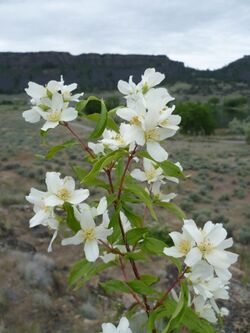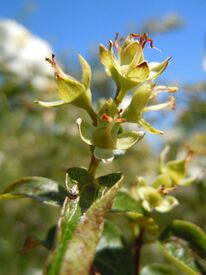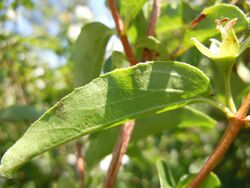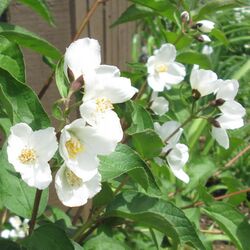Biology:Philadelphus lewisii
| Philadelphus lewisii | |
|---|---|

| |
| Scientific classification | |
| Kingdom: | Plantae |
| Clade: | Tracheophytes |
| Clade: | Angiosperms |
| Clade: | Eudicots |
| Clade: | Asterids |
| Order: | Cornales |
| Family: | Hydrangeaceae |
| Genus: | Philadelphus |
| Species: | P. lewisii
|
| Binomial name | |
| Philadelphus lewisii | |

| |
| Distribution of Lewis' mock orange (Philadelphus lewisii) | |
Philadelphus lewisii, the Lewis' mock-orange, mock-orange, Gordon's mockorange, wild mockorange,[1] Indian arrowwood, or syringa,[2] is a deciduous shrub native to western North America, and is the state flower of Idaho.[2]
It was first collected for science by scientist and explorer Meriwether Lewis in 1806 during the Lewis and Clark Expedition, and so was named after him.[3][4]
Description
The perennial shrub[5] is rounded and grows to 1.5–3 meters (4 ft 11 in–9 ft 10 in) in height. It sends out long stems which are red when new and fade to gray with age, the bark shredding in small flakes.[6]
The oppositely arranged leaves vary in size across individual plants but they are usually oval, 3–5 centimeters (1 1⁄4–2 in) long, smooth or serrated along the edges, and light green in color with a rough texture.[6]
The flowers are produced in clusters at the ends of long stems, with four white petals up to 4 cm (1 1⁄2 in) long and numerous yellow stamens. At the height of flowering, the plant is covered in a mass of blossoms. The flowers have a heavy, sweet scent similar to orange blossoms with a hint of pineapple.[6]
The fruit is a small hard capsule about 1 cm long with woody, pointed wings, containing many brown seeds.[7] Drought will stunt fruit development and prevent the production of viable seeds.[8]
The plant is somewhat similar in appearance to serviceberry.[9]
Distribution and habitat
Lewis' mock-orange occurs from northwestern California in the Sierra Nevada, north through the Pacific Northwest to southern British Columbia, and east to Idaho and Montana.[10] In the Cascades it occurs from sea level up to 7,000 feet (2,100 m), while in the Sierra Nevada it grows from 1,000–5,000 feet (300–1,520 m).[8]
Though it is tolerant of moderate shade, it prefers full sun. It is common in open coniferous forests and on forest edges, and in drier regions of the Northwest it occurs mostly in wetter and riparian areas. It is also found in chaparral and seral communities.[8]
It occurs on well-drained, moist sites, and is tolerant of rocky soil, and it is hardy from USDA zones 3 to 9.[7][8]
Ecology
The foliage of Lewis' mock orange is of moderate importance as winter forage for elk and deer in British Columbia, Idaho, and Montana. In Montana, a 1957 study found that it comprised 2% of mule deer diets in the winter and a trace in the summer.[8]
The seeds are eaten by quail and squirrels.[8]
It occurs in dense shrub habitats which provide good thermal and security cover for wildlife.[8]
Philadelphus lewisii is able to spread vegetatively and from seed. It forms seedbanks in the top 2 inches (5.1 cm) of soil.[8]
Fire ecology
The shrub is native to relatively arid regions of the American West which experience frequent wildfires, and is therefore quite well adapted to fire. Although mock-orange is typically completely top-killed by fires, it will enthusiastically resprout from rhizomes and root crowns afterward.[8] A 1971 study found that in the next growing season after a fire, mock-orange had already regrown to 50% of its previous diameter and height, and that those plants had an average of 28.9 to 38.0 sprouts per plant postfire compared to just 0.6 to 1.5 before.[11]
Lewis' mock orange palatability for Rocky Mountain elk is much greater after fire, with 36.3% of twigs browsed compared to only 1.3% on adjacent unburned sites.[8]
Human use
Ethnobotany
Native American tribes used P. lewisii for numerous purposes. The hard wood was useful for making hunting and fishing tools, snowshoes, pipes, combs, cradles, netting shuttles, and furniture. The leaves and bark, which contain saponins, were mixed in water for use as a mild soap.[12]:787 [1] The flowers were used in preparing perfumes and teas.[12]:787
Cultivation
Lewis' mock-orange prefers full sun to partial sun. It is drought-tolerant, will grow in poor soils, and is suitable for xeriscaping.[7] It provides a landscape with flashy flowers and a fruity scent.
The Waterton Mockorange Philadelphus lewisii 'Waterton' was hybridized by the Alberta Horticultural Research Station in Brooks, Alberta, Canada. It grows to 4–6 ft. (1.2-1.8 m) in height. It is named for Augustus Griffin, who in 1933 noted that this plant was growing in what is now Waterton Lakes National Park in Canada.[7]
Symbolism
Philadelphus lewisii is the state flower of Idaho. The plant is protected by Idaho state law along with other native wildflowers and shrubs, and it is illegal to collect wild specimens on public property for export, sale, or transport without approval.[13]
References
- ↑ 1.0 1.1 Lewis' Mockorange Philadelphus lewisii Pursh, Plant guide, 21 November 2003, http://plants.usda.gov/plantguide/pdf/pg_phle4.pdf, retrieved 23 March 2016
- ↑ 2.0 2.1 "State Symbols USA: Idaho State Flower". 2 October 2014. http://www.statesymbolsusa.org/Idaho/flower_syringa.html.
- ↑ "Wildflowers - Syringa Philadelphus lewisii Hydrangea family". USDA. http://www.fs.usda.gov/detail/boise/learning/nature-science/?cid=fsed_009688.
- ↑ Shaw, N. L. Philadelphus lewisii. In: Francis, J. K. (ed). Wildland Shrubs of the United States and its Territories: Thamnic Descriptions. USDA Forest Service. GTR IITF-WB-1.
- ↑ "Lady Bird Johnson Wildflower Center - The University of Texas at Austin". https://www.wildflower.org/plants/result.php?id_plant=phle4.
- ↑ 6.0 6.1 6.2 "Mock Orange, Philadelphus lewisii". https://calscape.org/Philadelphus-lewisii-().
- ↑ 7.0 7.1 7.2 7.3 "Waterton Mockorange Philadelphus lewisii Waterton", Dave's Garden, http://davesgarden.com/guides/pf/go/94024/#b, retrieved 23 March 2016
- ↑ 8.0 8.1 8.2 8.3 8.4 8.5 8.6 8.7 8.8 8.9 "Philadelphus lewisii". https://www.fs.fed.us/database/feis/plants/shrub/philew/all.html#MANAGEMENT%20CONSIDERATIONS.
- ↑ Taylor, Ronald J. (1994) (in en). Sagebrush Country: A Wildflower Sanctuary (rev. ed.). Missoula, MT: Mountain Press Pub. Co. pp. 166. ISBN 0-87842-280-3. OCLC 25708726. https://www.worldcat.org/oclc/25708726.
- ↑ "Philadelphus lewisii" (in en-us). https://www.wnps.org/native-plant-directory/184-philadelphus-lewisii.
- ↑ Leege, Thomas A.; Hickey, William O. (July 1971). "Sprouting of Northern Idaho Shrubs after Prescribed Burning". The Journal of Wildlife Management 35 (3): 508. doi:10.2307/3799705. ISSN 0022-541X. http://dx.doi.org/10.2307/3799705.
- ↑ 12.0 12.1 Bonner, Franklin T. (July 2008). The Woody Plant Seed Manual. Washington, DC. ISBN 978-0-16-081131-9. https://permanent.access.gpo.gov/LPS113557/LPS113557/www.nsl.fs.fed.us/nsl_wpsm.html. Retrieved 23 March 2016.
- ↑ "Section 18-3911 – Idaho State Legislature" (in en-US). https://legislature.idaho.gov/statutesrules/idstat/title18/t18ch39/sect18-3911/.
External links
- Idaho Statutes: State Flower
- Jepson eFlora: Philadelphus lewisii
- Plants of British Columbia: Philadelphus lewisii
- University of Michigan, Dearborn: Ethnobotany of Philadelphus lewisii
- "Philadelphus lewisii". http://www.pfaf.org/user/Plant.aspx?LatinName=Philadelphus+lewisii.
Wikidata ☰ Q7182890 entry
 |





